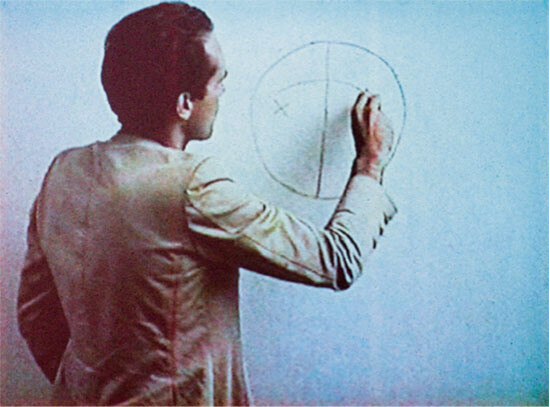Clapping the Board / Hotel Utopia / Traces of a Staging / Fate of Alien Modes / Diagrams (Circles) / History and Production / Kids and Movies / Birds, Capitalism, Dreams / More on Animals (Donkeys), Capitalism, and Dreams / JLG / Flipcharts / Factory Walls, Secrets / Attachments
1. Clapping the Board
A simple lesson I learned from Harun Farocki: on set, you can clap the clapboard quietly too.
2. Hotel Utopia
The works discussed in this piece exemplify, in a necessarily fragmentary manner, how Harun Farocki’s thought and oeuvre informed the way I think about images, film history, and contemporary political narratives, as well as my artistic and curatorial practices. They also touch on a matter of vital importance: how to transfer films into art spaces. As someone who comes from a visual art background, the question was more precisely how films can be transferred into the dispositiv of fine art.
I’ve been acquainted with Harun Farocki’s films and installations since the nineties, thanks in no small part to a common friend, Christa Blümlinger, who has followed Farocki’s work for decades in writing. Blümlinger’s essay about his first installation, Interface (Schnittstelle, 1995), aroused my interest in his cinematic and artistic methods.1 In 1999, I wanted to invite Farocki to a film program called “Hotel Utopia.”Harun answered my email instantly, in a very friendly manner. He wrote that he liked the title of the program, as well as my introductory text. I was happy about that. We showed three films: As You See (Wie man sieht, 1986), Images of the World and the Inscription of War (Bilder der Welt und Inschrift des Krieges, 1988) and the single-channel version of the aforementioned Interface (1995).
Art and cinema have each brought forth their own methodologies of exploring and changing the origins and mechanisms of the images they create. On a horizon (which they have in common, and which could span a desert or a swamp, or a space to escape from that has no vanishing point: the white of a projection screen. It could be a photograph; or a still from a sequence that swallows itself like a Mobius strip, and so the final image becomes extinguished; A drive-in theater, a Memento Mori, a studio set, a strange memory. The illuminated frame of the projection screen captures in its glow all images in their respective durations, transforms them into an epitome of time, and so erases their history … What exactly are we seeing? A short flare in the darkness of a movie theatre, past moments contained in the archives of big news agencies, or captured in Okinawa on a French tourist’s 35 mm film2
I haven’t read that text in fifteen years. Today I understand what Farocki liked about it.
3. Traces of a Staging
In 2001, I curated a film program and exhibition called “Traces of Staging” (Spuren der Inszenierung) featuring works by Harun Farocki (Inextinguishable Fire [Nicht löschbares Feuer,1969]; I Thought I Was Seeing Convicts [Ich glaubte, Gefangene zu sehen, 2001–4]; The Machines No Longer Work Blindly [Die Maschinen tun die Arbeit nicht länger blind, 2001]).3 On one night, we also showed What Farocki Taught (1998) by Jill Godmilow, as well as works by Wendelien van Oldenborgh (It’s full of holes, it’s full of holes) and Olaf Metzel (Stammheim Dokumente). This excerpt summarized our interest in these works:
The new work can be described as a representational interplay, a breakdown of Farocki’s recent investigations that link with his new work on intelligent machines, intelligent weapons and how these mutually advertise each other. Seen together, the shift from a society of discipline towards a society of control is an essential part of Farocki’s work and is accordingly represented as a line of thought along which both installations develop. Farocki writes: “The images produced by a surveillance camera could be called operative, as well as these of production control and material testing. It’s just fine to call a testing that is operated through sensors ‘damage free’: gazes don’t destroy anything.”4
4. Fate of Alien Modes
In the exhibition “Fate of Alien Modes” (2003), I showed the film Narrating (Erzählen, Ingemo Engström and Harun Farocki, 1975).5
The exhibition reflected my interest in the relationship between art and cinema, and their respective modes of production and narration—particularly “the narrative style, the how of the narration”—instead of following the what, the story.6 This, in film theory language, is the distinction Bakhtin and the Russian formalists drew between “fabula” and “syuzhet”: from the raw material of the plot, the syuzhet, the story (fabula) arises in the mind of the viewer. The plot “is, essentially, the sequence of all causally effectual events as we see and hear them, the series of actions as they are arranged in the film … ”—that is to say, the narrative mode, how the story is told. “Fate of Alien Modes” revolved around the thesis that an analysis of narrative modes (or “scripts”), as they occur in the institutions of cinema, art, psychoanalysis, and architecture, allows more insight into contemporary social, political, and economic conditions than, for example, using hermeneutical techniques for interpreting an oeuvre. Harun Farocki’s work was never about interpretation (of images, texts, films). His goal was, rather, to pinpoint preexisting, structurally laid out constellations, which are hard to identify (or that which had been omitted from the images, as Farocki’s work Images of the World and the Inscription of War [Bilder der Welt und Inschrift des Krieges] demonstrates so well), and that point to questions of interpretive power, symbolic representations, and of institutional discourses about images. He did this in order to make these systems visible not only for himself but for everybody else as well, and thus to create linguistic but most of all, visual terms—tools with which one could continue working, thinking, and discussing.
5. Diagrams (Circles)
In Farocki’s oeuvre, the diagram emerges as a possibility to formalize what has become visible, in a general configuration that isn’t linguistic but pictorial and exemplary. The methodological diagram that underlies the film Telling (Erzählen)—a circular narrative model—became one of the base figures for the exhibition “Fate of Alien Modes,” whose content and space developed in accordance with the notion of narrative and architectonic circles. Thus, the exhibition assumed the form of a spatial narrative,7 thanks in no small part to a Farockian diagram on the wall.
Between Two Wars (Zwischen zwei Kriegen, 1978)—and one could name further examples—also depicts the circle in different variations, doubles, reflections, as a central motif. Take, for example, the scene with the roundelof children in the mirror, which inspires the engineer’s concept of rationalization and eventually leads in an indirect way to fascism; or the chalk circle that a rollerskating girl leaves on the cobblestones (skatemarks as a symbol of eternity, or as a mobius strip of history that must repeat itself); or, finally, the wristwatch on the window sill, itself a citation of Slatan Dudow and Bertolt Brecht’s Kuhle Wampe (1932), which is put to the side before the character jumps out the window—a visualization of the symbolic circle that one has left: life.
“How to learn from the dying of the dead for the life of the living.” Farocki wrote this line in a production note while shooting Between Two Wars. In this film, the diagram outgrows the paper (the theory), to emerge in different parts of its structure as a trail—but also, in particular, as practice. This is another aspect of Farocki’s productions that was always of particular interest to me: the insoluble relationship between theory and practice, and the notion that artistic production is impossible without theory.
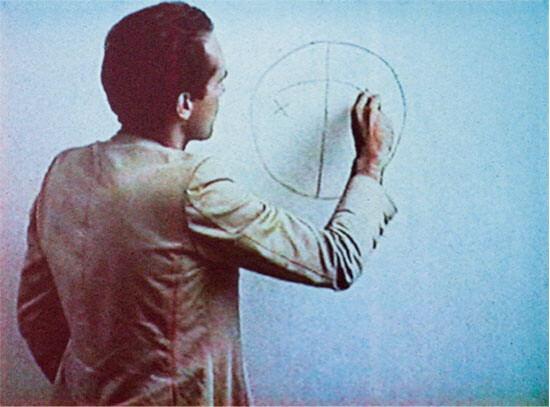

7. History and Production
From the production of history to “History and Production”: at my request, Farocki selected eighteen issues of Filmkritik, the magazine he co-published and contributed to from 1974 to 1984, for the exhibition, and wrote about its history in the catalog:
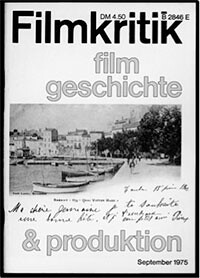

Cinema in the German Federal Republic of 1957 had nothing to do with Jutzi, Lang, Murnau, Pabst, or von Sternberg anymore, and writing about film had nothing do with Eisner or Kracauer. Those names were hardly in circulation anymore, and so it was incumbent on Filmkritik to spell them out again. Literature and art magazines also had to rebuild their connections with the world—severed by Hitler—but had already begun that process in 1945. When Filmkritik started in 1957, the Federal Republic had a film industry that pretended to be as confident as its car industry, except that it hadn’t created a mass product like the Beetleor a work of art like the Porsche. The word “Filmfreund” (film friend) is likely a Germanization of the term “cinéphile.”
In Berlin of the 1920s, there had been an interesting connection between the intelligentsia and the cinema, just as there was in Paris with Cocteau, Man Ray, or Léger making films. Brecht made films, so did Moholy-Nagy; and Ruttman was a painter before he made the “Symphony.” More importantly, maybe, Alfred Döblin was appropriating cinematic narrative techniques in his writing; he wanted to learn something from film. The writers and intellectuals of the time considered cinema kitsch, as Wolfgang Koeppen demonstrated in his postwar novel Pigeons on the Grass (Tauben im Gras). In that book, cinema is depicted as a flight from reality, and the movie businessis depicted as decadent. Adorno, as a proponent of the New Vienna School, also didn’t think very highly of film, which seemed to him on par with operettas.
Filmkritik certainly didn’t want to be a pamphlet for the film industry. It also polemicized against a brand of feuilleton-style art criticism, which just noted ideas and impressions. The goal was to “expose structures.” Filmkritik wanted to teach something, the love of film. It did so earnestly but with little enthusiasm, like it was a duty. In its early years, the magazine was a bit pedantic, reading films according to a very narrow formula, and judging, for example, a character’s actions in allegorical terms; if it uncovered an unwitting attitude in a movie, this was explained in the tone of academic psychology. But it was able to change, and developed its own terms to criticize its early practice. During the first ten or twelve years, Filmkritik changed, steadily mostly, sometimes with a jolt, and in that way it was always ahead of its readership, to which I belonged, also.8
8. Kids and Movies
A few days after Farocki’s sudden passing, I discovered the following letter-to-the-editor in an old copy of Filmkritik. I now consider it one of my favorite Farocki texts.
dear filmkritik,
the white rose youth center is on apostel-paulus street in schöneberg. it shows films once a week. today our kindergarden ismeant to go there. i look into the schedule to know when to pick them up. it announces “keine angst vor großen tieren” [Don’t be Afraid of Big Animals]. an hour of hectic activity follows to prevent our kids from getting screwed up by a film with heinz rühmann. but our kindergartner says that it’s certainly not a feature film, the series only shows cartoons. no word on this in the program.
ten pfennig entry. the hall is full. on screen: the disgusting studio black and white of the 1950s, which comes out of weak projectors provided by the landesbildstelle looking particularly disgusting. i ask the guy who is responsible for the program, who’s still the old landlord type, not the new social worker type, what moved him to show a film with such a disgusting little-man message, and that, of all places, in a building that commemorates the scholl siblings. but the cast is good, he says, and there are no children’s films, and it’s rated 6, and when I ask whether he’s seen it, he says nah, but we can discuss when it’s over (he doesn’t attend the screening).
shouldn’t we now make an offer to all these institutions, offer them films and sources that enable our children to find the broadest solutions to the world’s problems. couldn’t gloria behrens, who comes to mind, maybe make a list of children’s movies and we can keep it in a booklet, which at least could help us take advantage of the existing opportunities.
luckily anna got sick watching the movie, so that she didn’t have to listen to the finale, don’t be afraid of big animals, nothing can happen to you, anymore.
regards HF
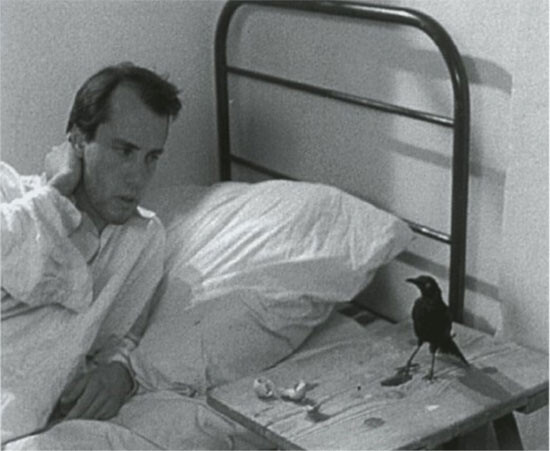

9. Birds, Capitalism, Dreams
Between Two Wars contains a dream sequence. The shot shows a young man recounting a dream, shortly after waking up. An apparently tame black bird (a daw) sits next to his bed on a small night table, beside a broken egg:
I had a dream last night. I dreamt of a bird, which laid eggs and started brooding them. Then it got hungry. It pecked a hole in the first egg and slurped it empty. After a while, the brooding had so exhausted the bird that it pecked open the next egg. And in the dream I felt that I was becoming the bird that laid eggs and wanted to hatch them, but had to eat to brood them, and so in this way it devoured itself.
This scene not only recounts a dream, but the account of the dream is itself part of the dream. The symbolism of the account (the bird) materializes in what seems to be the narrator’s waking state, on top of a night table, which, before the cut-in, had other objects on it: a shaving brush, a cup, a mirror. Now, a bird is sitting there instead. The retelling of the dream begins with a strange doubling, itself a dream—or as if elements of the dream are manifesting in reality.
Later in the film, the symbolism of the dream becomes even more pointed, a metaphor for capitalism itself. A drawing is held to the camera. On it, we see a bird eating the eggs in its nest, rather than brooding them. The words “Our Future” are inscribed on the egg it just broke. On another egg: “Our World.” And on the bird’s back, looking like a crest of feathers: “Capitalism.”
A text in voice-over:
The egotism of the moment arises from the fact that the capitalist mode of production wastes energies that, from a technical point of view, should have long been utilized in the production process. On one side, man gets squeezed and forced into the maelstrom of hard work; and, on the other, natural resources are overexploited if they aren’t of use to private capital. That’s the contradiction that Marx outlined—the forces of production are overburdening the relations of production.
Farocki’s oeuvre is a kaleidoscopic constellation. Like the young engineer in Between Two Wars who wants to look at himself in the mirror but discovers something quite different, viewers will not discover themselves in Farocki, but rather a consistent array of motifs and subjects, which pervade the prisms of his oeuvre in countless adaptations, refractions, repetitions, and variations. His oeuvre itself seems to function like an optical device at times.
Many of his subjects already emergedin Between Two Wars: war, arms production, the associated “theory of the gun,”fascism, factories, labor, narration, a critique of capitalism. One even finds nature footage in the film, which reminded me of depictions of artificial, digital nature in Farocki’s last work, Parallel I–IV (Paralelle I–IV).
Nature as Farocki captured it, even in the city, was always in motion, always lively and soulful. A wind that’s almost stormy blows through the trees and the bower, blows through branches and leaves. The wind says: things will not stay the way they are. They can change. In Parallel I–IV, Farocki advances ideas about the ontology of real and digital trees, about branches and foliage, about the way they move in the virtual wind, and he uncovers the operations and parameters that underlie these dynamics.
On a related note, I remember that HF criticized how we shot nature in our film My Never Ending Burial Plot (2010). At the time, he suggested we watch how Straub-Huillet filmed nature, and learn from them. I think I get what he meant only now. In fact, I think I would have already gotten it back then if he’d referred me to his own work, instead of to Straub-Huillet—to the trees in Between Two Wars, for example, their leaves swaying in the wind.
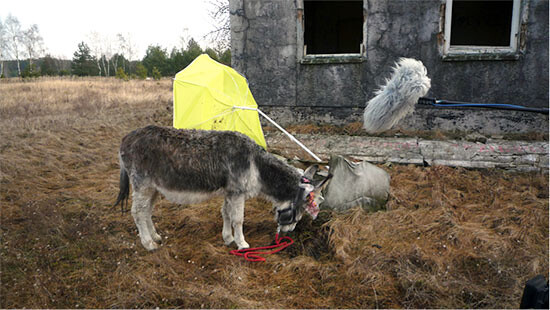

10. More on Animals (Donkeys), Capitalism, and Dreams
In an email last year, Harun Farocki wrote me:
Dear Constanze,
anyway, I dreamt that a donkey was licking my feet. “They’re salty from sweat,” I thought. The literary source is Grimmelshausen’s Simplicius Simplizissimus, of course, the Germanist would say. I say: Your donkey,
Your Harun
The donkey character in Cold Rehearsal (Kalte Probe), the film Christine Lang and I made together in 2012, was conceived in an artistic system of exchange, via a system that didn’t squander energies, but recycled them, as references, quotes, testimonials—just as the young engineer in Between Two Wars demands. The donkey, which has two cameos in Cold Rehearsal—one as a living donkey and another as a papier-mâché statue—refers not only obviously to Bresson’s Balthazar. It was inspired by Farocki and is firmly dedicated to him. It came about like this:
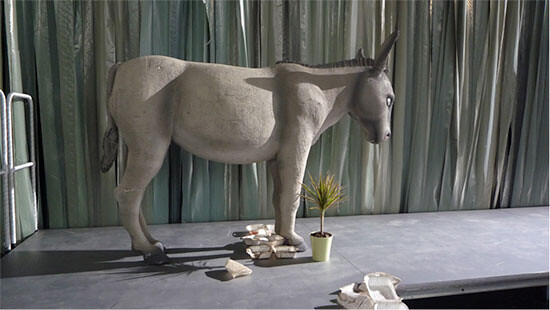

In the publication Das Erziehungsbild im Kino, edited by Tom Holert and Marion von Osten, Farocki’s essay with the wonderful Farockian title, Learn What’s Easiest! (Lerne das Einfachste!), recounted the shooting of one of his first films, which he directed with Hartmut Bitomsky. He states:
The second economic film marked the end of our didactic rigorism. The film was conceptualized as a film. We no longer wanted to predetermine the lesson of every part, and how it should be taught. The production was a massive effort. We totally overreached. Every morning before shooting we did several hours of moving. At one point, we shot a Roman banquet in an abandoned barracks—two Romans discussing the economy. I don’t recall why we didn’t co-opt the discourse of the Greeks, the way Marx did.9
We had wanted a palm tree and a miniature donkey for that scene, but, instead, our colleagues got a miniature palm tree, which looked like a room plant, and a full-sized donkey, who had no desire to let anyone push him up the stairs to the third floor, and even less desire to go back down.10
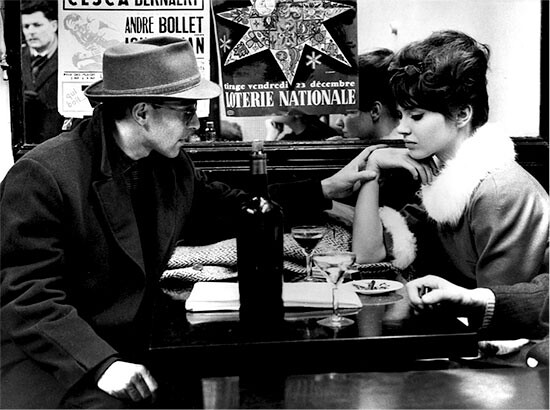

Is that a rehearsal for the film, then—or the real thing? How many facial expressions can one have?
11. JLG
Ten years ago, I shot X NaNa / Subroutine in Berlin. The short film tells the story of Nana (Anna Karina), a character from Godard’s Vivre Sa Vie, who has decided to leave Godard’s film to become real and manage her own affairs. In X NaNa / Subroutine, Farocki plays Frank I. Chou (an anagram of his name)—a mixture of Zeus (NaNa/Mnemosyne’s lover), a parole officer, a psychoanalyst, and a filmmaker. He was endlessly patient with me and my predicament; as instead of directing, I was busy reparking cars, returning keys, and I-don’t-know-what, stuff that’s usually handled by production management or set runners, employees I couldn’t afford. Only the clapboard was being clapped too loud for his taste; I was responsible for that too (see above). In the script, I put Godard’s words in Farocki’s mouth:
Chou: I often watch people … I look at them … very particular faces, and I think: “I would need a camera to really see them.” The problem is that directors not just use the camera, they put themselves in its place. But the camera needs independence. The “real” reverse shot has yet to be realized. The Americans have beaten the shot/reverse shot principle to death—they turned it into a trivial game of ping-pong, devoid of all meaning. The director no longer tries to have two people really look at each other, listen to each other, let alone think about each other … imagine that, six possibilities squared. You could make years of film from that.
Nana: A gunshot in a movie … is also a shot. A gunshot is just one side of the truth.
Chou: [turns to her, touches her face] The truth always has two faces … one image shows the shot, the other, the countershot.
Constanze Ruhm, X NaNa / Subroutine, 2004. Film still, color, 30’.
For his role as Frank I. Chou, HF—the owner of a carefully curated selection of very colorful Hawaiian shirts—wore his favorite shirt: James Dean and Marilyn Monroe’s pink faces on a poison-green background. He was only partially agreed with the lines I had written for him. In an odd way, his performance in this short represented an indirect segue to our respective relationships to Godard (Godard himself was played by H. M. Rehberg in the film). Apart from our shared interest in the director—albeit, from very different generational perspectives—there was another thing we had in common regarding Godard. Once, we confessed to each other that we never wanted to get to know him.
I now realize that we didn’t talk about Godard as much as one might assume. “Not Speaking About Godard,” one might say.
Farocki once wrote me the following.
Dear Constanze,
this morning I thought: you were taking on Godard, but nobody’s taking on the Sopranos, which is similar to people boycotting H&M, but nobody boycotting Apple, whose crimes are well known.
—Harun Farocki in an email on April 22, 2014


12. Flipcharts
One of Farocki’s methods of teaching us something consisted of showing us how something else is taught to others. His film Die Bewerbung provides a great example of this. Of that film, Farocki writes:
In the summer of 1996, we filmed application training—courses that teach you how to apply for a job. We filmed long-term unemployed people who the welfare office had forced to participate; and we filmed managers with 200,000-mark salaries who hired private coaches in the same way that the free citizens of Athens received rhetorical instruction from house slaves.
An inevitable element in this world of schooling, retraining, and risk management negotiations—in workshops, staff retreats, and conflict-resolution seminars—is the flipchart. The flipchart is a sad, unsightly testament to contemporary existence and its work modes; it documents quiet dramas, the silent failures of countless useless business ventures and (probably fortuitously) unrealized management ideas; it is a performative tool of neoliberal self-expression. There doesn’t seem to be a German translation of this term, but that doesn’t mean that there are no flipcharts in Germany. In fact, we see them in many of Farocki’s films.
13. Factory Walls, Secrets
I’ve started taking photographs. At the moment, I’m photographing factory walls, because they are impermeable, unclimbable and so encapsulate the logic of capitalist production. The owner cannot rise above them. His own wall blocks his view of the rest of society. I’ve started taking photographs. A picture is not enough, by the way. You have to take two pictures of everything. Things move so much that it takes at least two pictures to capture the direction of the movement.
This passage is also from the film Between Two Wars, and comments on a tracking shot along a factory wall. Many years later, in the course of preparations for his Documenta contribution Deep Play (2007), Farocki told us how complicated the research for the work had been, how uncooperative corporations and institutions were. Their company philosophies plastered the walls with terms like “transparency” and “openness.” According to Farocki, the real problem was that these organizations had nothing to hide anymore: the thing that had to be hidden was that there was nothing to hide. The lack of secrets was the secret.
14. Attachments
We wrote each other a lot over the years—mostly emails, but sometimes letters too. If it was really important but there was no time to send a letter, and an email seemed inappropriately disdainful, we made use of a special method, or gesture, invented by Farocki—a way of returning to the letter form within the confines of a profane email. He sent the letter as an attachment, while the body of the email remained empty.
This text may be something like that—an attachment, which of course also expresses attachment:
I last encountered Harun at this year’s documentary forum in the HKW in Berlin. We sat on the riverbank in the sun, with Christian Petzold,and spoke about Peter Lorre, Brecht’s direction of Man Equals Man (Mann ist Mann), and Polish cinema (Farocki once told me that Poland had become a place of longing for him, like Paris, when he saw the film Ashes and Diamonds in 1961.11 That at that time he read magazines with titles like Polish Monthly (Monatschrift Polen) with grainy photos of young people, and that he dreamed of maybe attending film school there one day. However, things turned out differently, he said). We spoke about Marey, about his recordings for deaf-mutes—a man moves his lips silently saying, Bonjour Madame, Bonjour. Farocki said that soccer players and coaches cover their mouths during World Cup games because lip-readers could otherwise decode what they’re saying: Let’s smack him in the face. The ball is round. It’s only offside if the referee blows his whistle.
I took notes of our conversation, as I often did when we met and spoke in depth. It was a beautiful day, we laughed a lot, and later there was a guided tour through Farocki’s latest installation, Parallel I–IV (Paralelle I–IV). Among other things, Parallel deals with the relationship of digital models to cinematic images. One sees how clouds are constructed digitally, and then the picture cuts to real cloud formations. Black and white flickering, old film material, a beach, dunes, the sky—the picture is a bit sped-up, in my memory—a sky from the previous century, not yet inhabited by drones.
I always wanted to ask Harun what film that beautiful excerpt is from. And I kept forgetting. That, and many other questions, I will now have to answer myself.
I learned from HF how to sometimes see the world through his eyes; his films make that possible. His eye was sharp and inquiring; and even if it was ironic, it remained full of respect and genuine interest for his subject. Above all, it was full of warmth.
Even the protagonists of Nothing Ventured (Nicht ohne Risiko, 2004) are deeply moving. They spend their strange lives (they have no idea how strange their lives are) between fear (of the venture-capital project’s failure) and hope (of taking part in the grand neoliberal game), between stubby, fear-scented office buildings (stuffed entirely, it seems, with needle felting carpet and flipcharts), and lonelypizzerias in the fleeting winter afternoon light, on the peripheries of midsized German cities. But they are deeply moving characters because we see them through Harun’s eyes.
From HF, as e-mail attachment, November 21, 2013. Subject: Chirp.
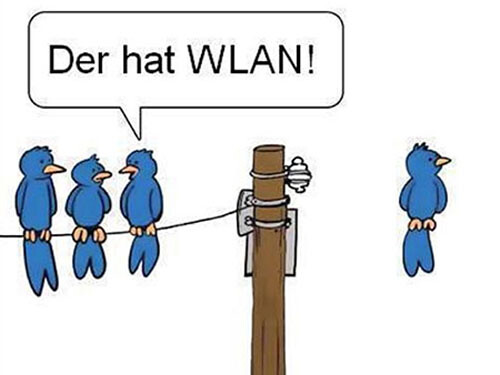

Christa Blümlinger, “Harun Farocki, circuit d’images” in Trafic 21 (Spring 1997): 44–49; “Harun Farocki, Bilderkreislauf” in Ärger mit den Bildern. Die Filme von Harun Farocki eds. Rolf Aurich and Ulrich Kriest (Konstanz: UVK Medien, 1998), 307–315 ; “Image(circum)volution: On the Installation Schnittstelle (Interface),” in Senses of Cinema; as in Thomas Elsaesser (ed.), Harun Farocki: Working on the Sight-Lines (Amsterdam: Amsterdam University Press, 2004), 315–322; “Bild(krets))lopp. Om installationen Schnittstelle,” in OEI 37 & 38 (2008): 48–57.
Constanze Ruhm, “Hotel Utopia,” Summerstage Festival (Vienna, 1999).
For the haus.0-program of the Künstlerhaus Stuttgart, which was run by Fareed Armaly at the time.
Fareed Armaly and Constanze Ruhm, NICHT löschbares Feuer / Spuren der Inszenierung, exhibition brochure (haus.0 and Künstlerhaus Stuttgart, 2001).
“Fate of Alien Modes” was an exhibition I curated at Vienna Secession.
In Thomas Elsaesser and Malte Hagener, Filmtheorie zur Einführung (Hamburg: Junius Verlag GmbH, 2011), paraphrase.
Mark Rakatansky, “Spatial Narratives,” 1999 / “Räumliche Erzählungen,” translation and publication on the Künstlerhaus Stuttgart website (www.haussite.net/site.html), German and English text.
Harun Farocki in Fate of Alien Modes, ed. Constanze Ruhm (Vienna: Secession Wien, 2003).
In the anthology The Education Image (Das Erziehungsbild), eds. Tom Holert and Marion von Osten (Vienna: Schriften der Akademie der bildende Kunste Wien, 2010).
Harun Farocki and Hartmut Bitomsky, Eine Sache, die sich versteht, 1971.
Andrzej Wajda, 1958.
Translated from German by Leon Dische Becker.
